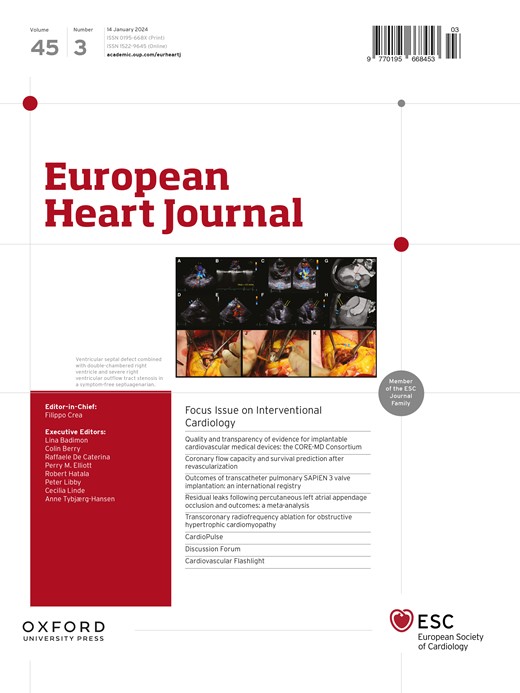Transient anticholinergic burden and out-of-hospital cardiac arrest: a case-crossover study.
IF 35.6
1区 医学
Q1 CARDIAC & CARDIOVASCULAR SYSTEMS
引用次数: 0
Abstract
BACKGROUND AND AIMS Anticholinergic burden has been linked to cardiovascular events and mortality, but its association with out-of-hospital cardiac arrest (OHCA) remains unclear. This study investigated whether transient increases in anticholinergic burden elevate OHCA risk in middle-aged and older populations. METHODS A nationwide case-crossover, case-time-control, and case-case-time-control study using Taiwan's National Health Insurance Research Database involved 173 974 adults aged ≥40 years who experienced OHCA between 2011 and 2021. The participants were middle-aged (40-64 years) or older (≥65 years). Anticholinergic burden was assessed using established scales and categorized as 0, 1-2, and 3 or more points. Each participant's burden during the hazard period (days -30 to -1 before OHCA) was compared to a randomly selected 30-day reference period (from days -180 to -61). Conditional logistic regression was used to estimate odds ratios (ORs) with 95% confidence intervals (CIs). RESULTS Case-crossover analysis showed more patients having higher anticholinergic burden during the hazard period than during the reference period in both age groups. The ORs for OHCA were 1.48 (95% CI: 1.42-1.55) and 1.56 (95% CI: 1.52-1.61) for scores of 1-2, compared with 0, and 2.03 (95% CI: 1.95-2.11) and 2.21 (95% CI: 2.15-2.27) for scores of 3 or more, compared to 0, in the middle-aged and older groups, respectively. Case-time-control and case-case-time-control analyses consistently showed a dose-response relationship, with results confirmed by sensitivity analyses. CONCLUSIONS Transient increases in anticholinergic burden significantly raise OHCA risk, particularly among individuals with higher burden levels.一过性抗胆碱能负荷与院外心脏骤停:一项病例交叉研究
背景和目的抗胆碱能负荷与心血管事件和死亡率有关,但其与院外心脏骤停(OHCA)的关系尚不清楚。本研究调查了抗胆碱能负荷的短暂增加是否会增加中老年人群的OHCA风险。参与者为中年人(40-64岁)或老年人(≥65岁)。使用已建立的量表评估抗胆碱能负荷,并将其分为0、1-2和3分或更多。将每个参与者在危险期(OHCA前-30天至-1天)的负担与随机选择的30天参考期(从-180天至-61天)进行比较。使用条件逻辑回归估计95%置信区间(ci)的优势比(ORs)。结果病例交叉分析显示,两组患者在危险期抗胆碱能负荷均高于对照期。在中老年组中,1-2分的OHCA的or分别为1.48 (95% CI: 1.42-1.55)和1.56 (95% CI: 1.52-1.61),与0相比;3分及以上的OHCA的or分别为2.03 (95% CI: 1.95-2.11)和2.21 (95% CI: 2.15-2.27),与0相比。病例-时间-对照和病例-时间-对照分析一致显示剂量-反应关系,敏感性分析证实了这一结果。结论抗胆碱能负荷的短暂增加显著增加OHCA风险,特别是在负荷较高的人群中。
本文章由计算机程序翻译,如有差异,请以英文原文为准。
求助全文
约1分钟内获得全文
求助全文
来源期刊

European Heart Journal
医学-心血管系统
CiteScore
39.30
自引率
6.90%
发文量
3942
审稿时长
1 months
期刊介绍:
The European Heart Journal is a renowned international journal that focuses on cardiovascular medicine. It is published weekly and is the official journal of the European Society of Cardiology. This peer-reviewed journal is committed to publishing high-quality clinical and scientific material pertaining to all aspects of cardiovascular medicine. It covers a diverse range of topics including research findings, technical evaluations, and reviews. Moreover, the journal serves as a platform for the exchange of information and discussions on various aspects of cardiovascular medicine, including educational matters.
In addition to original papers on cardiovascular medicine and surgery, the European Heart Journal also presents reviews, clinical perspectives, ESC Guidelines, and editorial articles that highlight recent advancements in cardiology. Additionally, the journal actively encourages readers to share their thoughts and opinions through correspondence.
 求助内容:
求助内容: 应助结果提醒方式:
应助结果提醒方式:


